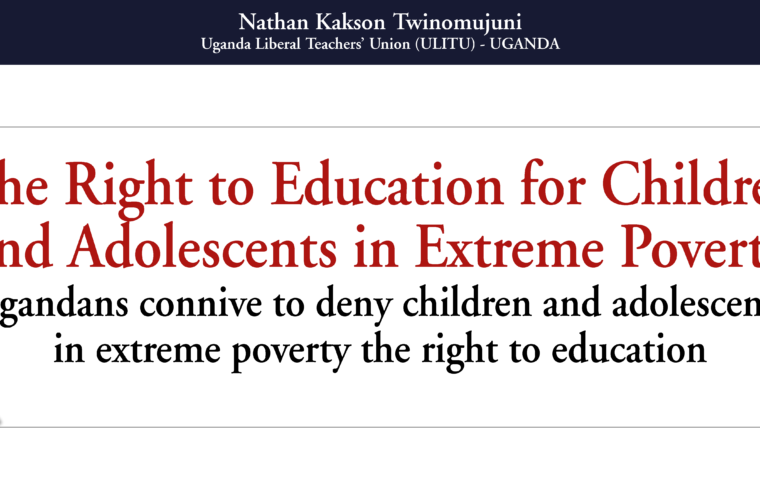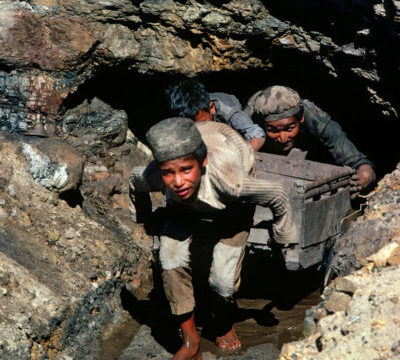Nathan Kakson Twinomujuni
Uganda Liberal Teachers’ Union (ULITU) – UGANDA
Uganda is a developing country where majority of the people are categorized as poor. The country joined the rest to adopt the sustainable development goals (SDGs) to be achieved by 2030 and is steadily making remarkable progress towards the goals. Efforts to reduce poverty in the country have yielded some tangible results. According to World Bank, the percentage of Ugandan households living in poverty was halved by 2013. However, the northern region, which has been described as the poorest in the country, still has 33 percent of the population still living under extreme poverty. Children and adolescents in this section of the population have limited or no access at all to education. Government efforts to salvage the situation are frustrated by what I choose to refer to as self-seeking school managers who have instead continued to lock such children and adolescents out of schools.
The government of Uganda started implementing Universal Primary Education (UPE) in 1997 with the aim of increasing the number of the country’s children accessing primary education. In 2007 the same government embarked on implementing Universal Secondary Education (USE) and Universal Post Primary Education and Training (UPPET) to absorb the UPE graduates. These programs cater for children and adolescents. According to government policy, children in these public schools must not pay any tuition fees as this became the responsibility of government. This is almost similar to free education, but parents were left with the responsibility to provide uniforms, exercise books and food for their children while at school. These programs resulted into increase in enrolment in both primary and secondary schools in the country. For example, according to Ministry of Education, Science, Technology and Sports (2016), UPE increased the transition rate to Senior One from 51% in 2006 to 73% in 2007; and USE increased access to secondary level from 18.6% in 2006 to 24.7% in 2015.
Whereas on the national scale statistics paint a more beautiful picture, analysis at the grassroots indicate otherwise. For instance, according to the Uganda Bureau of statistics (UBOS, 2014) in some remote districts in the north of the country, over 50 percent of the children of school-going age were not actually going to school, while in the Capital City 5.1 percent were not going to school in 2014. The situation might not have become any better today. This is an appalling situation!
Although the government has, through UPE, USE and UPPET programs, created conditions that greatly increased access to school for children and adolescents, what actually goes on in public schools keeps away those from extremely poor families. The transition from a situation where fees per child would be collected from parents to one where schools have to wait for government releases was not a smooth one for school administrators. Two reasons made the transition not easy. One, the release of funds from government would delay which made it diffi cult for schools to meet running costs especially at the beginning of a school term; and two, the funding itself was found inadequate by mangers of schools who had previously been collecting and managing huge sums. Prior to UPE and USE, a primary school child was paying a minimum of Uganda Shillings (UGX) 20,000 and a secondary school child a minimum of UGX 60,000 per term. This was obviously much more money compared to the UGX 2,700 and UGX 41,000 that government pays per child per term for primary and secondary respectively. To get a clear picture of these fi gures one needs to use the conversion rate of 1 US Dollar to UGX 3,650.
In a bid to make up for the delayed and inadequate government funding, some schools slowly and quietly started charging children fees. Today, most public primary schools are charging a minimum of UGX 10,000, while secondary schools charge a minimum of UGX 30,000. This is not to mention those that are charging UGX 50,000 and above. The fees charged are given different names by different schools, for example, development fee, lunch fee, library fee, etc. In most schools, the money raised for fees is used to facilitate teaching staff in terms of feeding, transport, housing, and other allowances; ultimately to make the fi – nancial position of the teacher better.
Although the government claims to be committed to its policy of non-payment of fees, it has not moved out strongly to apprehend school administrators who contravene the policy provisions by charging fees or to deter them from doing it. It should be noted that schools, especially secondary schools, have their annual budgets showing sources of income to the Ministry of Education and Sports for approval, and they are actually approved. This is a clear indication that the staff at the ministry are either not concerned about schools charging fees or are just supportive of the act. Due to this laxity, schools which started charging small amounts of money have progressively increased the fees, ultimately going back to what the situation was prior to UPE, USE and UPPET or even worse. For example, the school where I work started by charging UGX 5,000, later increased it to 50,000, then to 75,000, and is slated to increase to 100,000 as suggested by a section of parents at their meeting just before COVID- 19 lockdown. I believe the same has happened in many other schools. What is disheartening about this is that this fee increment is being proposed at a time when government has increased its funding per child.
This rapidly growing and unchecked move by public school administrators to charge fees has closed doors for children and adolescents in families living in extreme poverty, ultimately denying them a chance to benefi t from the UPE and USE programs, since they are unable to pay. This amounts to nothing less than gross violation of this category of people’s human right to education. The government’s continued laxity to take measures to stop charging fees or apprehend those doing it is a sign of failure in its obligation to ensure access to education for all its people. This, therefore, makes one wonder as to who is there for people in extreme poverty, if government is not.
There is dire need to do something about this situation as a big number of children are being left out. To this effect, I would like to make these suggestions. One; the government of Uganda should come out strongly to enforce its policy of non-payment of any fees and apprehend those that contravene the policy. Two; the government should work towards paying a living wage so that school managers are not tempted to charge fees for purposes of enhancing their staff salaries. Three; measures to eliminate poverty must be expedited so that everybody is able to afford their children’s education requirements.
References
Ministry of Education, Science, Technology and Sports.
(2016). National USE/UPPET and UPaOLET Headcount 2015,
A report on the USE/UPPET and UPOLET National Headcount
June 2015. Kampala.
Uganda Bureau of Statistics (UBOS). (2014). National Population
and Housing Census 2014. Kampala.











